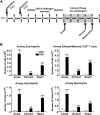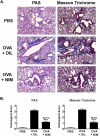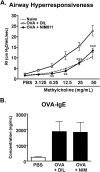Blocking cyclophilins in the chronic phase of asthma reduces the persistence of leukocytes and disease reactivation
- PMID: 21493785
- PMCID: PMC3262693
- DOI: 10.1165/rcmb.2011-0007OC
Blocking cyclophilins in the chronic phase of asthma reduces the persistence of leukocytes and disease reactivation
Abstract
Allergic asthma is characterized by acute influxes of proinflammatory leukocytes in response to allergen stimulation, followed by quiescent (chronic) periods between allergen challenges, during which sustained, low-level inflammation is evident. These chronic phases of disease are thought to be mediated by populations of leukocytes persisting within airways and tissues. The lack of any in situ proliferation by these cells, along with their limited lifespan, suggests that a continual recruitment of leukocytes from the circulation is needed to maintain disease chronicity. The mechanisms regulating this persistent recruitment of leukocytes are unknown. Although classic leukocyte-attracting chemokines are highly elevated after acute allergen challenge, they return to baseline levels within 24 hours, and remain close to undetectable during the chronic phase. In the present study, we investigated whether an alternative family of chemoattractants, namely, extracellular cyclophilins, might instead play a role in regulating the recruitment and persistence of leukocytes during chronic asthma, because their production is known to be more sustained during inflammatory responses. Using a new murine model of chronic allergic asthma, elevated concentrations of extracellular cyclophilin A, but not classic chemokines, were indeed detected during the chronic phase of asthma. Furthermore, blocking the activity of cyclophilins during this phase reduced the number of persisting leukocytes by up to 80%. This reduction was also associated with a significant inhibition of acute disease reactivation upon subsequent allergen challenge. These findings suggest that blocking the function of cyclophilins during the chronic phase of asthma may provide a novel therapeutic strategy for regulating disease chronicity and severity.
Figures






References
-
- Cookson W. The alliance of genes and environment in asthma and allergy. Nature 1999;402(Suppl):B5–B11 - PubMed
-
- Cohn L, Elias JA, Chupp GL. Asthma: mechanisms of disease persistence and progression. Annu Rev Immunol 2004;22:789–815 - PubMed
-
- Corrigan CJ, Hartnell A, Kay AB. T lymphocyte activation in acute severe asthma. Lancet 1988;1:1129–1132 - PubMed
-
- Walker C, Kaegi MK, Braun P, Blaser K. Activated T cells and eosinophilia in bronchoalveolar lavages from subjects with asthma correlated with disease severity. J Allergy Clin Immunol 1991;88:935–942 - PubMed
-
- Larche M, Robinson DS, Kay AB. The role of T lymphocytes in the pathogenesis of asthma. J Allergy Clin Immunol 2003;111:450–463, quiz 464 - PubMed
Publication types
MeSH terms
Substances
Grants and funding
LinkOut - more resources
Full Text Sources
Other Literature Sources
Medical

